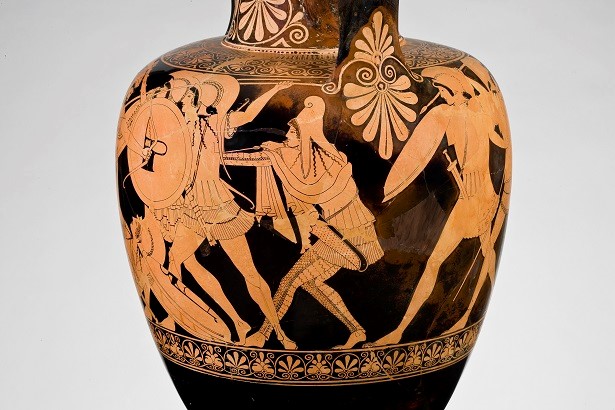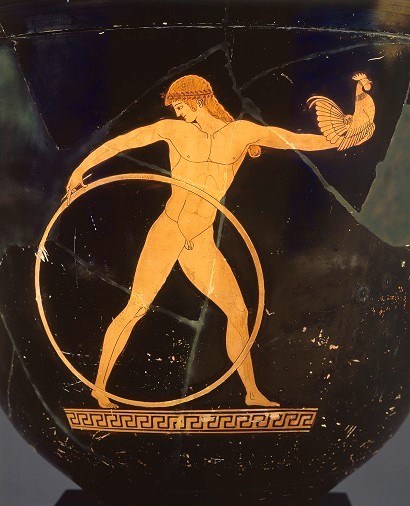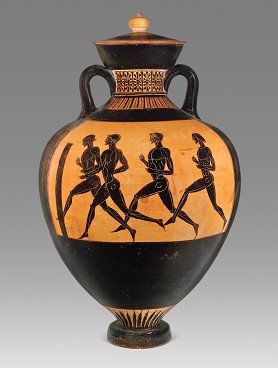그리스 도기 '베를린 화가' 특별전@프린스턴대 미술관(3/4-6/11)
The Berlin Painter and His World: Athenian Vase-Painting
in the Early Fifth Century B.C.
First Major Exhibition of One of the Most Admired Artists of the Ancient Mediterranean World
PRINCETON, N.J. – The Berlin Painter was the name given by the great Oxford scholar Sir John Beazley (1885-1970) to an anonymous fifth-century B.C. Athenian vase-painter, whose hand Beazley recognized in over 200 complete or fragmentary vases in collections around the world. Since Beazley’s first published identification of the Berlin Painter in 1911, attributions to this remarkable and prolific artist have grown to over 300 works, and esteem for his refined and elegant style has never waned.

Greek, Attic, attributed to the Berlin Painter, Black- figure Panathenaic prize amphora: A, Athena between columns surmounted by roosters; B, Runners, ca. 480–470 B.C. Ceramic. Collection of Gregory Callimanopulos . Imagen courtesy Gregory Callimanopulos.
The Berlin Painter and His World: Athenian Vase-Painting in the Early Fifth Century B.C. is the first major museum exhibition devoted to the artist, whose work had a major impact on other vase-painters of the period, when Athens and all of Greece were threatened with enslavement by the Persian Empire. The exhibition will present 84 vessels and statuettes from the period, including 54 of the finest vases attributed to the Berlin Painter, providing a window into the world of Athenian society 2,500 years ago.
Extraordinary loans from the Antikensammlung, Staatliche Museen zu Berlin; Musée du Louvre, Paris; British Museum, London; Staatliche Antikensammlungen und Glyptothek, Munich; Metropolitan Museum of Art, New York; Kunsthistorisches Museum Vienna; Ashmolean Museum, Oxford; Museum of Fine Arts, Boston; and Vatican Museums, among other institutions, will be included alongside major objects from the Princeton University Art Museum and private collections.
The Berlin Painter and His World is curated by J. Michael Padgett, curator of ancient art at the Princeton University Art Museum, whose principal research interests are Greek art and archaeology, particularly Attic vase-painting.
The exhibition premieres at the Princeton University Art Museum March 4 through June 11, 2017, before traveling to the Toledo Museum of Art in Ohio from July 7 through Oct. 1, 2017. “This exhibition affords the all-but-unique experience of accessing the world of ancient Greece some 2,500 years ago through the hands of a single, unnamed artist,” notes James Steward, the Nancy A. Nasher-David J. Haemisegger, Class of 1976, Director. “The fruit of a lifetime of thinking and research, the exhibition brings us into very intimate contact with one of the great artists of the ancient world and in doing so reminds us of the power of the individual artist then and now.”

Greek, Attic, attributed to the Berlin Painter, Red- figure neck-amphora with ridged handles: Amazonomachy with Herkales, ca. 490–480 B.C. Ceramic. Antikenmuseum Basel und Sammlung Ludwig (BS 453). Image courtesy Antikenmuseum Basel und Sammlung Ludwig.
Most Athenian vase-painters of the sixth and fifth centuries B.C. did not sign their work. Beazley recognized the same artist’s hand on a number of red-figure vases of the first quarter of the fifth century B.C. in different public and private collections; in a seminal 1911 article in the Journal of Hellenic Studies, he attributed them to an anonymous Athenian craftsman whom he named the Berlin Painter. Beazley and other scholars were attracted to the artist’s elegant and finely detailed style, which set his work apart from that of his contemporaries.
“I am excited that there will be over 50 vases by the Berlin Painter himself in the exhibition,” said curator Michael Padgett. “They vary in size, shape and subject matter, but each is painted in the artist’s distinctive style, even the many animals that appear in his work, including what must be the most adorable dog in all of Greek art.”
The objects in the exhibition will range in size from towering volute-kraters and stately amphoras to slender oil bottles (lekythoi) and delicately potted jugs (oinochoai). Dynamic scenes of cult practice, athletic and musical performances, and the rich body of Greek myth and epic are represented in novel compositions that demonstrate the Berlin Painter’s artistic sophistication and lengthy, multiphase career.
Among the many acknowledged masterpieces featured in the exhibition will be the Berlin Painter’s name-vase from Berlin, a red-figure amphora, which incorporates an innovative conflated design of a fawn standing between the Greek god Hermes and a satyr; a stamnos showing the infant Herakles strangling snakes in his crib (a portent of his future powers), from the Louvre; and a hydria of Apollo seated on a winged tripod, from the Vatican.

Greek, Attic, attributed to the Berlin Painter, Red- figure bell-krater: A, Ganymede; B, Zeus, ca. 500–490 B.C. Ceramic. Paris, Louvre Museum, Department of Greek, Etruscan, and Roman Antiquities (G 175). © RMN-Grand Palais / Art Resource, NY.
Other leading artists of the period, many of them close associates of the Berlin Painter, are represented in the exhibition and shape a wider context for the times: his teacher Phintias; his principal rival, the Kleophrades Painter; his students Hermonax, the Providence Painter, and the Achilles Painter; followers such as the Dutuit Painter and the Tithonos Painter; and artists who specialized in decorating wine cups: Onesimos, Makron, the Brygos Painter and the Triptolemos Painter.
Accompanying the exhibition will be a major catalogue published by the Princeton University Art Museum, which will trace the trajectory of the Berlin Painter’s career as well as examine the nature and context of his achievement. The catalogue will offer nine essays and 84 object entries by an international group of scholars, as well as an updated catalogue raisonné of works by the Berlin Painter, including several new attributions.
An international scholarly conference on Athenian vase-painting of the Late Archaic and Early Classical periods, organized in conjunction with the exhibition, will be held at Princeton on April 1, 2017.
The Berlin Painter and His World: Athenian Vase-Painting in the Early Fifth Century B.C. has been made possible by generous support from Annette Merle-Smith; the Stavros Niarchos Foundation; the National Endowment for the Arts; the Leon Levy Foundation; Hiram Butler; James and Marilyn Simons; the Stanley J. Seeger ’52 Center for Hellenic Studies, Princeton University; Frederick H. Schultz Jr., Class of 1976; and Susan and John Diekman, Class of 1965. Additional support has been provided by Harlan J. Berk, Ltd.; Raynette and Edward O. Boshell Jr.; Ross and Carol Brownson; Gregory Demirjian and James Demirjian; Davide Erro, Class of 1991; William Suddaby; Stark and Michael Ward; the Department of Classics, Princeton University; the Allen R. Adler, Class of 1967, Exhibitions Fund; Paul and Victoria Hasse; Fortuna Fine Arts; Mr. and Mrs. Jonathan Rosen; and several anonymous donors. Further support has been made possible by the New Jersey State Council on the Arts and by the Partners and Friends of the Princeton University Art Museum.
Additional generous support for the publication has been provided by the Barr Ferree Foundation Fund for Publications, Department of Art and Archaeology, Princeton University; the Andrew W. Mellon Foundation Publications Fund; and European Dynamics Luxembourg SA.
# # #
About the Princeton University Art Museum
With a collecting history that extends back to 1755, the Princeton University Art Museum is one of the leading university art museums in the country, with collections that have grown to include over 97,000 works of art ranging from ancient to contemporary art and spanning the globe.
Committed to advancing Princeton’s teaching and research missions, the Art Museum also serves as a gateway to the University for visitors from around the world. Intimate in scale yet expansive in scope, the Museum offers a respite from the rush of daily life, a revitalizing experience of extraordinary works of art and an opportunity to delve deeply into the study of art and culture.
The Princeton University Art Museum is located at the heart of the Princeton campus, a short walk from the shops and restaurants of Nassau Street. Admission is free. Museum hours are Tuesday, Wednesday, Friday and Saturday 10 a.m. to 5 p.m.; Thursday 10 a.m. to 10 p.m.; and Sunday 1 to 5 p.m. The Museum is closed Mondays and major holidays.







